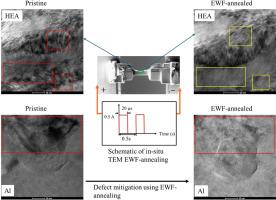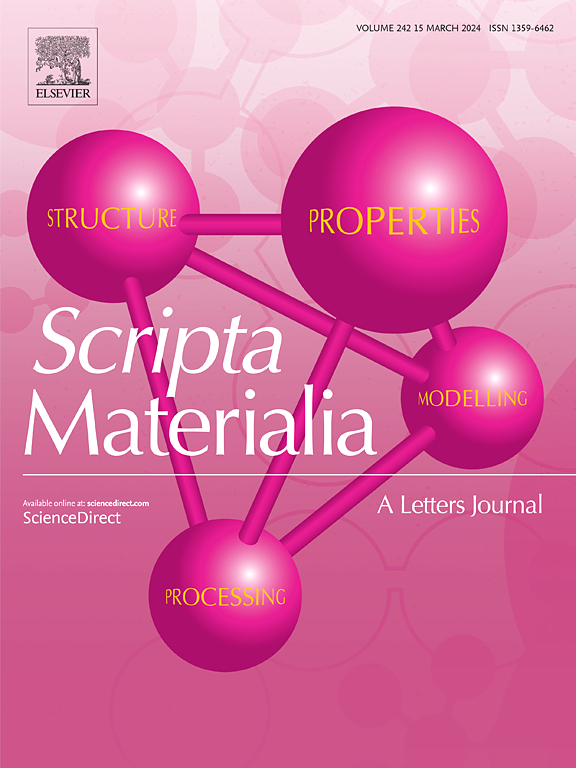Athermal defect recovery in high entropy alloys: Real-time evidence from in-situ TEM
IF 5.6
2区 材料科学
Q2 MATERIALS SCIENCE, MULTIDISCIPLINARY
引用次数: 0
Abstract
Conventional annealing of high-entropy alloys relies on elevated temperatures to promote defect recovery and microstructural refinement, but such treatments are slow, composition-dependent, and often lead to uncontrolled grain growth. In this study, we explore electron wind force (EWF) as a low temperature, athermal route to rapid defect mitigation in a CuCoNiFeCr system. Using in-situ transmission electron microscopy, we directly tracked the same microstructural region while increasing EWF magnitude. Our observations revealed a progressive reduction in defect density. Short duration (40 µs), low frequency (2 Hz), low-current (0.1 A) pulses mitigated most of the mobile defects in 5 min. Increasing current amplitude drove extensive defect migration, with limited grain growth. Ex-situ annealing of bulk HEA corroborated these findings, showing a ∼26.8 % decrease in electrical resistance and a ∼12.5 % reduction in hardness, consistent with dislocation annihilation and structural relaxation. Similar recovery trends observed in aluminum confirm the generality of the approach.

高熵合金的非热缺陷恢复:来自原位透射电镜的实时证据
传统的高熵合金退火依赖于提高温度来促进缺陷的恢复和微观组织的细化,但是这种处理是缓慢的,依赖于成分,并且经常导致不受控制的晶粒生长。在这项研究中,我们探索了电子风力(EWF)作为CuCoNiFeCr系统中快速减少缺陷的低温、非热途径。利用原位透射电镜,我们在增加EWF量级的同时,直接跟踪了相同的微观结构区域。我们的观察显示缺陷密度逐渐降低。短时间(40µs)、低频率(2hz)、低电流(0.1 A)脉冲在5分钟内减轻了大部分移动缺陷。电流振幅增大,缺陷大量迁移,晶粒生长受限。体HEA的非原位退火证实了这些发现,显示电阻降低~ 26.8%,硬度降低~ 12.5%,与位错湮灭和结构松弛一致。在铝中观察到的类似的恢复趋势证实了该方法的普遍性。
本文章由计算机程序翻译,如有差异,请以英文原文为准。
求助全文
约1分钟内获得全文
求助全文
来源期刊

Scripta Materialia
工程技术-材料科学:综合
CiteScore
11.40
自引率
5.00%
发文量
581
审稿时长
34 days
期刊介绍:
Scripta Materialia is a LETTERS journal of Acta Materialia, providing a forum for the rapid publication of short communications on the relationship between the structure and the properties of inorganic materials. The emphasis is on originality rather than incremental research. Short reports on the development of materials with novel or substantially improved properties are also welcomed. Emphasis is on either the functional or mechanical behavior of metals, ceramics and semiconductors at all length scales.
 求助内容:
求助内容: 应助结果提醒方式:
应助结果提醒方式:


